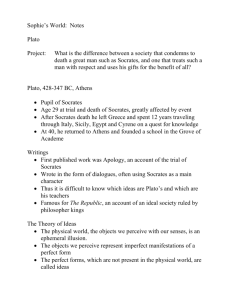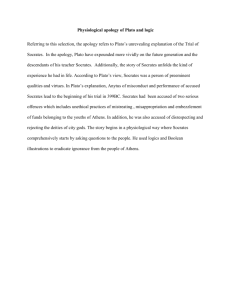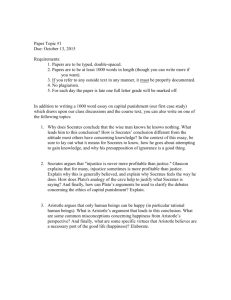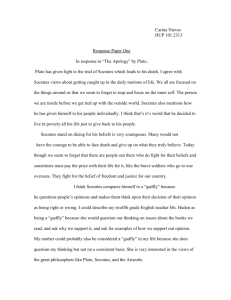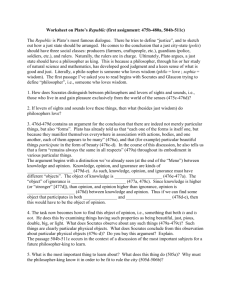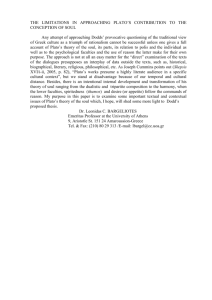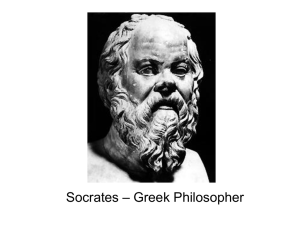Link to paper
advertisement
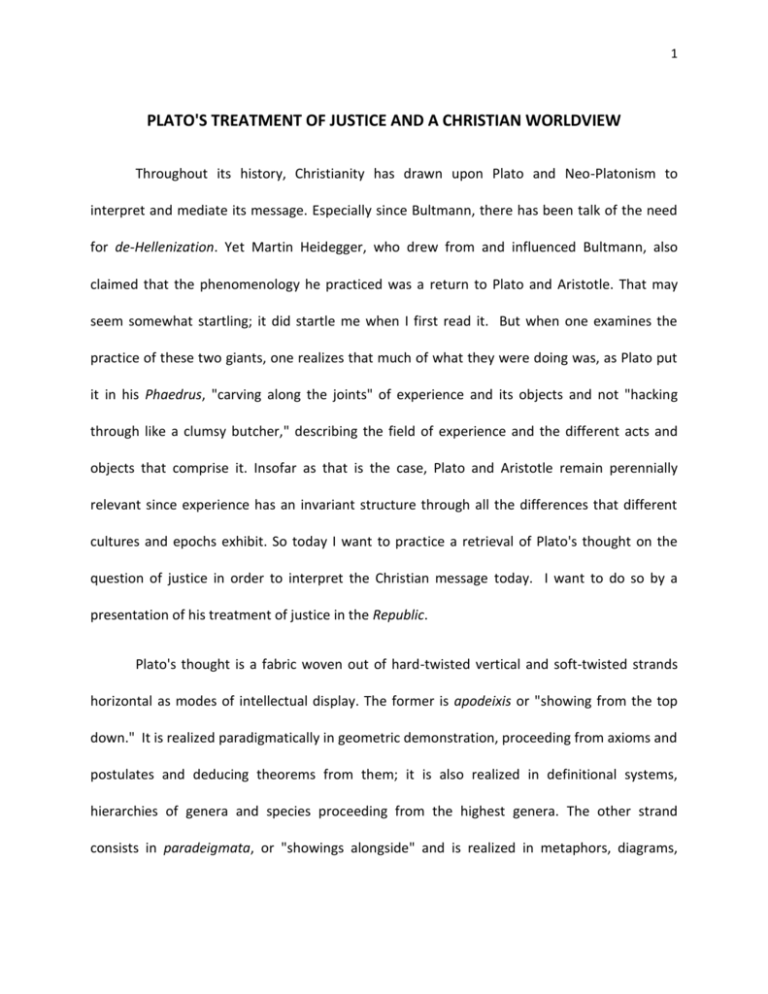
1 PLATO'S TREATMENT OF JUSTICE AND A CHRISTIAN WORLDVIEW Throughout its history, Christianity has drawn upon Plato and Neo-Platonism to interpret and mediate its message. Especially since Bultmann, there has been talk of the need for de-Hellenization. Yet Martin Heidegger, who drew from and influenced Bultmann, also claimed that the phenomenology he practiced was a return to Plato and Aristotle. That may seem somewhat startling; it did startle me when I first read it. But when one examines the practice of these two giants, one realizes that much of what they were doing was, as Plato put it in his Phaedrus, "carving along the joints" of experience and its objects and not "hacking through like a clumsy butcher," describing the field of experience and the different acts and objects that comprise it. Insofar as that is the case, Plato and Aristotle remain perennially relevant since experience has an invariant structure through all the differences that different cultures and epochs exhibit. So today I want to practice a retrieval of Plato's thought on the question of justice in order to interpret the Christian message today. I want to do so by a presentation of his treatment of justice in the Republic. Plato's thought is a fabric woven out of hard-twisted vertical and soft-twisted strands horizontal as modes of intellectual display. The former is apodeixis or "showing from the top down." It is realized paradigmatically in geometric demonstration, proceeding from axioms and postulates and deducing theorems from them; it is also realized in definitional systems, hierarchies of genera and species proceeding from the highest genera. The other strand consists in paradeigmata, or "showings alongside" and is realized in metaphors, diagrams, 2 allegories, and myths. The latter incarnate thought in imagery. For all the dualist language Plato employs with regard to the human soul, his thought is essentially incarnate. As part of the soft-twisted strands, metaphors, or rather metaphoric pairs, structure the Republic. The opening words are carefully chosen: "I went down to the Peiraeus yesterday...and was about to return up to the city." The physical going down and going up is a metaphoric pair for injustice and justice, going down and going up in human life. When are we as humans going up and going down? Is there a measure? Socrates and Glaucon, his companion, decide to stay into the night to watch a torchlight procession on horseback. We are present here with another and closely related metaphoric pair, light and darkness. Going up is going into the light; going down is descending into the darkness. These pairs furnish a basic substructure to the work. They are not arbitrarily chosen; they are built into the fabric of human life. Before the invention of electrically lighting, when the sun went down people laid down to sleep; when the sun rose, they rose up to the light of day. We spontaneously use these metaphoric pairs to speak of human values. The central question of the dialogue, the nature of justice, is introduced through Socrates' meeting with old Cephalus, a rich man offering sacrifices to the gods. He remarked that when he was young he thought the good was pleasure; when he got older he thought it was riches (he made a fortune as a shield maker); now that death is approaching, he thought it just may be justice. This is where Socrates raises the central question as to the nature of justice. It is the thought of death that leads Cephalus to question his own life as a whole. 3 At the end of the dialogue Plato concocts the myth of Er who was supposed to have gone to the afterlife and seen the rewards and punishment meted out according to the justice or injustice of their lives. He was allowed to come back to talk about them. Death and the possibility of an afterlife furnish the utterly sober context of raising the question of the nature of justice. In the beginning, Socrates teases a kind of definition out of Cephalus: justice is telling the truth and paying back what you owe—we might call this commercial justice. His son Polemarchus picks up the argument and claims that what are owed are benefits to friends and harm to enemies. We might call this interstate justice: benefiting allies and harming enemies. Thrasymachus places everything in a new light, claiming that justice is the self-interest of the stronger and that laws are made by the stronger in their own self-interest. For their subjects, justice consists in obeying the law. We might call this realistic justice—the justice typically practiced in states. Socrates shows himself the strongest in argument and explains what true human self-interest entails as he rules the assembled interlocutors. What I find one of the most significant aspects of his subsequent extended argument is the way he frames the question of the just and unjust man. He does so in relation to a central aspect of interpersonal relations: the distinction between appearance and reality. Martin Buber called attention to eight views involved in any dyadic relation between people: I as I appear to you and you as you appear to me; I as I want to appear to you and you as you want to appear to me; I as I appear to myself and you as you appear to yours; finally, I as I really am and you as you really are. Socrates picks up on these complications by invoking the myth of the Ring of 4 Gyges. A shepherd found the ring on a corpse in a cave, put it on, and found out that when he turned the signet around, he disappeared. He then used his invisibility to seduce the queen and kill the king. Here Socrates asks us to perform a thought experiment: what if you had the ring of Gyges? What would you do or not do? Most good people would say they would do just what they regularly do. But the experiment has a deeper dimension: what if you disappeared, not only from the eyes of men, but also from the eyes of God? A recent survey indicated that 85% of those surveyed said they would do what they felt like doing. So how does the idea of God function? As stick and a carrot, threatening hellfire to those who break His commandments and promising heavenly bliss to those who follow them. Socrates' point is to see what justice and injustice do to the soul or the inner life of those who practice them, whether men and gods see or not, and consequently without consideration of what external benefits and harms might accrue. With that as a challenge, Socrates asks us to reverse the relation between appearance and reality, making the truly just man appear unjust and the truly unjust man appear just. The latter would reap all the rewards given by others for his appearance; the former would reap the disadvantages meted out by the public. In this context, Plato has to have had Socrates himself in mind who was executed by the Athenians for questioning the values and practices of the citystate. The device he uses to display the inner character of the order or disorder of the soul is the construction of a city. His reason seems a bit odd: since we can't see the relatively small 5 character of souls, we can see that character writ large in the city. But the move does not appear to be so odd when we reflect on the mirror relation between the city and the soul: people tend to reflect the values functioning in the people around them and in the culture as a whole. He presents the city in three stages. The first in based upon fundamental need. Socrates calls it the "true and healthy city." Most insistent is the need for food, clothing, and shelter that are provided by a relatively simple division of labor. Glaucon focuses upon that and disregards what the people do on holidays: eating together and singing hymns to the gods. This fulfills a deeper need reflected in music and in the stories of the gods. Humans need beauty and some umbrella of meaning that underpins earthly existence as well as the more immediately insistent requirements of organic existence. Missing the aesthetic and metaphysical aspects, Glaucon see this as a city of pigs and asks for more luxuries: sweet meats and soft couches. Enter the luxurious city. In the first city there is a natural limit set by basic need; but is there a natural limit to luxury? A continually multiplying division of labor introduces into the city superfluous needs; the city becomes measureless, feverish, and bloated. The natural resources controlled by the city are insufficient to meet these steadily expanded needs. Enter the third city, the purged city. A new class is needed: a military class dedicated to war in the search for new resources. Now the training of the military involves a radically different lifestyle than that of the indulgent citizens. Training in gymnastics is obvious; but they are also trained in musike, that is, in fine art. Too much gymnastic, Socrates says, makes one brutish, too much fine art effeminate. The right 6 disposition is toughness and gentleness geared toward harming the enemies and benefiting the friends of the city. Now the military divides in two: into guardians and auxiliaries. This furnishes the city with three classes: the artisans as the largest class, the auxiliaries as significantly smaller, and the guardians as few or even one. Socrates has completed the construction of his civic image of the soul that he now analyzes into three levels corresponding to the three level of the city: the lower level is that of the appetites, the higher level that of the thumos or spirited part that is inclined to fight when one is challenged, and the top or ruling part is reason. At this point, he pulls four virtues seemingly out of thin air, those that in the subsequent tradition will be called the four cardinal virtues, i.e. the hinges of the moral life: temperance, courage, wisdom and justice. He attempts to locate them in relation to the three classes in the city. Wisdom lies in the ruling class and is linked to mind as the ruling aspect of the soul. Wisdom looks down on the lower appetites to govern them. In the city, courage is the typical virtue of the military auxiliaries that consists in died-in-the-wool patriotism and is linked in the individual to what the French call les coeur or the heart whose virtue is coeurage. Temperance Socrates describes as the agreement of all as to who should rule. In the soul that involves the subordination of desirous and competitive appetites to reason. What then is justice? Socrates suggests what it is by the old hippie motto, "doing one's own thing." Justice is the order that exists when each part does what is proper to it under the guidance of reason. One would think that we have what we were looking for: an insight into the nature of justice. But Socrates qualifies the previous: the courage here is citizen's courage, suggesting 7 there is another type. He says that if something appears in the soul that goes beyond this analysis they would have to rework that analysis—especially, if there is something we do "with the whole soul." Later He goes on to say, "If we knew what justice is...." So the description arrived at after the treatment of the cities and in relation to the three parts of the soul, though significant, is insufficient to do justice to the nature of the soul. This takes us to the end of Book IV. Socrates is about to take the view of the city and the soul he developed as measure to set up a hierarchy of civic and corresponding individual types according to how they approximate the rule of the wise, when the interlocutors ask him to tell more about one of his proposals: the community of wives and children. There will be no nuclear families, Socrates said: the best will mate with the best and the children will be raised communally. I suspect that the "and children" was not foremost in their minds, since Socrates does not first discuss what they asked but first proclaimed that women are equal to men and should be given equal education. As if to say, women are not to be objects of your prurient interest; they are the equal of men and their dispositions and intellects should be equally developed. Only then does he go on to discuss the community of women and children, at the end of which he says what seems again odd: that all Greeks are brothers; war between them should be viewed as a family quarrel and should not lead to the enslavement of the losers. A way to make sense of that is to see that Socrates is extending the circle of concern from the soul to the city and on to all Greeks preparatory to the next broadening he introduces by introducing the need for a philosopherking. Socrates presents this figure as the condition without which humankind as such will live in 8 misery. Now the circle of concern is extended from all Greeks to all humankind. This is something that was not at all what they asked for but which Socrates links to it by describing the philosopher-king as a peculiar erotic type. This calls for rising above the prurient erotic interest of the group to a real sublimation of eros. Whereas education in the purged city culminated in the appreciation of beautiful things, Socrates says that the philosopher is in love with the vision of Beauty Itself. This distinction between beautiful things and Beauty itself opens up an understanding of the full scope of the orientation of the human soul. The philosopher-king, Socrates says, is "the contemplator of all time and all being," and that is because he is the lover of the vision of Beauty itself that rules over all. The philosophic dimension of the soul is cosmopolitan; the philosopher is a citizen of the cosmos and not simply of a given city. Socrates uses three images, three soft-twisted horizontal strands, to describe the object of the philosopher's training: 1) the Sun as image of the Good that occupies the place of Beauty Itself, 2) the diagram of the Line, and 3) the allegory of the Cave. Socrates claims that, just as the sun as source of light is what makes possible the completed relation of seeing to the seeable, so also what he calls 'the Good' furnishes "light" for the relation between intellect and the intelligible. He goes on to fill the space between the two origins of light with an analysis of the field of experience. Socrates introduces a line, divided by a proportion and subdivided by the same proportion. If you follow the directions, you will discover that, no matter what proportion you 9 choose, the central segments will always be equal. Not just looking at, but thinking about what the line presents, we understand that we are dealing with a geometric theorem that is true always and everywhere. A visual object—for example the line in question—comes into being, changes, and passes out of being, while the geometric truth it exhibits never changes. Socrates then invites us to think about the nature of the mind that sees visual objects and apprehends geometric truths. While the eyeballs and the visual power that employs them are changing, the mind is oriented toward the realm of the unchanging intelligible. "All time and all being" that the philosopher is said to contemplate corresponds to the changing realm of the visual (all time) and the unchanging realm of the intelligible (all being). Now Socrates claims that intellectual apprehension occurs "in the light of" the Good. He puts us in position to cash in on the metaphor of light by suggesting that, as geometric proof moves "down" with necessity from the axioms and postulates to the theorems, there should be a possibility of moving "up" from the fewness of the axioms and postulates. Thinking that through leads to the suggestion that the Good is the One, the single principle governing all. It is in "the light of the One" that we understanding anything. Hearing a multiplicity of sounds in a foreign language, we know what it is not to understand. To understand a language is to grasp the unity that underlies the multiplicity of sounds. Viewing the multiplicity of metric rules discovered in the building process, the geometer grasps the underlying unity through axiomatization and deduction. It is in the search for unity in otherwise incoherent multiplicity that we come to understand anything. But what Socrates is after is the Origin of the general structure of the cosmos and the human being's place in it. 10 The allegory of the Cave puts the Line in a dramatic context where down and up and darkness and light are central. Humans are chained in a deep, dimly lit cave. By nature we are chained to sensory presentations; and by being born into a culture we are chained to the ways of understanding characteristic of the culture. Being unchained and forced to turn around, we can come to question the ways of understanding characteristic of the culture and what the senses reveal about the underlying things. Socrates sees human beings as chained to "images of justice" such as he examined in the beginning of the dialogue. Being unchained, turned around, and dragged out of the cave into the sunlight of intelligibility indicates the difficulty of intellectual ascent to the region introduced by geometry. Turning around through reflection, through metanoia or conversion, one ascends from semi-darkness to the light radiating upon all by the One/Good. Here is what going down and going up involve: ascending from the darkness of embodiment and culture to the Good as the light in which we can govern the body and reshape the culture. The view of the soul given at the end of Book IV turns out to be a flat projection lacking the crucial dimension of depth that indicates the solidity of the soul. Socrates indicates this obliquely when he underscores by a peculiar device what plane geometry leaves out and which we should pursue with all our power: the dimension of depth. That depth-dimension is the orientation upwards in the light of the One to the One as Beauty Itself. So we come to understand how the original metaphoric pairs, up and down, light and dark, are used to indicate the full scope of the human soul's activity. The rational soul looks down to rule its 11 appetites as the basis for its looking up to the cosmic Source toward which it is natively oriented, understanding which is living in the light. Socrates also uses the image of the spinning top as a picture of the properly ordered soul. If the top finds the upright position, the movements on its exterior support that position. If it deviates from uprightness, it begins to wobble; and if it deviates too far, the top hits the ground and the top is carried about erratically by the movements on the exterior. The upright position for the rational soul is its eros for the One as Beauty itself. Oriented towards it, the sensory life on the exterior supports that orientation and produces the harmonious soul. The upshot of the whole argument is that the just soul is the soul that is in love with the Good as the Source. It is such a soul that experiences inward harmony that is much more than mere complacency, for it is combined with a passionate movement toward the Source. The rational soul looks down to govern its lower powers so that it may be able to look up toward that which it seeks with all its power. One who is in love with the Good wants to see orientation toward the Good realized in the souls of men—precisely what moved Socrates in his encounters with his dialogical partners. He returned to the Cave to help release the souls from their chains, turn them around, and lead them up toward the Good. So there is an order and a disorder of the soul, whether men or even gods see it or not. It is an order generated by gathering its powers together in orienting itself toward what is highest. At the very end of the dialogue, in the myth of Er, Socrates introduces the notion of rewards and punishments in an afterlife for justice and injustice in this life. What is most important to see is that, as in Kant's ethical thought, rewards and punishments are not the 12 motives of the real ascent of the soul; it is passionate love of the Good as Source and End, as Alpha and Omega. What has this to do with a Christian worldview? St. Augustine structured his Confessions around the notion of the restless heart that is made for God. Matching the term of the Platonic ascent, the narrative of his life culminates in the exclamation: "O Beauty, ever ancient, ever new, late have I loved you." As a typical Church Father, Augustine further said that he read in the Platonists much of Christianity: the One as the Source generating the Logos as the region of the intelligible; the World-Soul as Spirit turned towards the world; the fallen condition of humankind lying chained in the darkness and the metanoia that turns us around toward the Father. But what he did not read, of course, was that the Logos became flesh. Platonism set Augustine on the right course that was completed by the revelation that is Christ. Against the background of Christianity, Kant retrieved part of Plato's project by distinguishing acting according to the ethical and acting because of the ethical. Honesty in business practices so you might make more money by being trusted is not moral action, even though it is not bad action; it is the inner disposition that counts. So doing and avoiding the right things in order to escape punishment or to gain reward in the afterlife—or to become prosperous in this life—Is not moral action. Moral action involves doing the right thing because it is right. One who is upright deserves rewards or punishments in the afterlife, but that cannot be the motive of the just life. However, Kant omitted the deeper dimension of passionate love for the Good as alpha and omega that stands at the center of Plato's thought. 13 The German poet Heinrich Heine, when he was outside at night looking at the stars with his mentor G.W.F. Hegel, remarked on the glory of God displayed in the heavens. Hegel, understanding where Heine was coming from, replied: You want to get paid for taking care of your mother and not killing your brother. Hegel underscored here a problem with all too many Christians: they want to get paid for keeping the rules. The point of Plato's Ring of Gyges tale is abstraction from extrinsic rewards and punishments. Focus upon these additions to one's life deflects attention from the intrinsic order and disorder of the soul. Defocusing such an orientation, Plato leads us to see what it means to act out of passionate love for the Good as Source: it establishes an essential harmony. For such a soul, rewards and punishments are not part of the motivation. My point in this paper is that love of God sets us beyond our hopes, beyond our fears, leading us from the death of the soul into eternal life. Plato divined that and can lead us to act, not out of a desire to get paid or out of a fear of punishment, but out of aspiring love of the Highest. In the way he taught that, he remains perennially relevant. * * *
